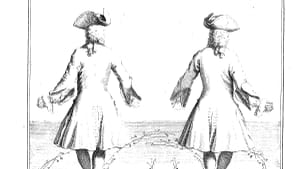Stay in the Loop
BSR publishes on a weekly schedule, with an email newsletter every Wednesday and Thursday morning. There’s no paywall, and subscribing is always free.
Baroque theaters and modern cathedrals
Tempesta di Mare closes their season

If you’ve ever heard the overture to Messiah, you’ve heard an 18th-century French overture. My Norton-Grove musical encyclopedia says the French overture begins with a slow stately section, followed by a lively middle section and a return to the opening. The encyclopedia entry also mentions things like dotted rhythms and fugal forms, but none of that technical language captures the feel of the music. Every time I hear those portentous opening bars, I feel like I’ve been transported to a small, candlelit 18th-century theater, hearing music that says something important is about to happen.
Tempesta di Mare played two lengthy suites of French theatrical music at its season finale. In both suites, the follow-through fulfilled the promise of the overture.
A Baroque theatrical suite is a parade of dances, airs, and other kinds of music taken from a theatrical production, such as a ballet or an opera. The individual pieces only last a minute or two, and they range through all the emotional and orchestral color the original production spread over several acts. Bright moments for trumpets and percussion follow airs for flutes and strings. Fast dances like the jig alternate with stately slow dances like the sarabande. In the first suite on this program, I think I even heard a demon moan during a bit labeled “Air de demons 1” (there were three demonish airs altogether).
Rhythms of dance and language
Tempesta di Mare has been exploring French Baroque music for two seasons, and you could hear the results of that concentration. In their program notes, Tempesta’s directors, Gwyn Roberts and Richard Stone, argue that the distinctive “flavor” of French Baroque music stems from two ingredients, “the rhythms of the dance and of the French language itself.” We don’t have a time machine so we can’t say Tempesta’s audience heard the same thing an18th-century French audience heard. But Tempesta’s two year immersion in that vanished culture has produced a style that feels artistically right.
The Tempesta di Mare event was the last scheduled concert of the Philadelphia music season. The end of the season always feels like an occasion, and the enterprising directors of Lyric Fest, pianist Laura Ward and mezzo Suzanne DuPlantis, marked the day with an unexpected extra: a song-packed, one-hour benefit at the Episcopal Cathedral in West Philadelphia. The benefit collected cash and food donations for the Food Pantry, the Cathedral program that distributes food to the needy every Monday.
I’m happy to attend any concert that lets me hear a mezzo like Suzanne DuPlantis sing one of Brahms’s viola songs. Brahms matched the viola with its vocal counterpart and created songs that bring out the most moving qualities in both partners. But Brahms’s Gestillte Sehnsucht was only one item in a program that presented 22 songs interpreted by DuPlantis and two sopranos with attractive voices and sensitive song styles, Anne Marie Frohnmayer and Elizabeth Racheva.
Mendelssohn and Dickinson
In good Lyric Fest style, the program spanned a spectrum that included lieder by Mendelssohn, Schubert, and Strauss; settings of Emily Dickinson texts; and songs by Aaron Copland, Stephen Foster, George Gershwin, and an American novelist, Paul Bowles. A group of songs devoted to spiritual themes included a trio arrangement of "As I Went Down to the River to Pray" and a lighthearted modern grace by Michael Tilson Thomas that begins “Thanks to whoever is there.” Laura Ward, as usual, produced accompaniments that painted scenes, created moods, and placed every song in a context.
The diocese removed the pews when it remodeled the cathedral several years ago and converted the sanctuary into a large flexible space that has hosted concerts by the Mendelssohn Club, Choral Arts Philadelphia, and the Crossing. In her brief welcoming remarks, the dean of the cathedral noted that the food collected by the church, including cooked meals, is distributed in the sanctuary. The space where people gather to worship is used for songfests and charitable acts. I find that touchingly poetic.
What, When, Where
Tempesta di Mare: Leclair, Music for Scylla et Glaucus. Rameau, Music for Les Fêtes de Polymnie. Tempest di Mare Philadelphia Baroque Orchestra. Gwyn Roberts and Richard Stone, Directors. Emlyn Ngai, Concertmaster. June 7, 2015 at Gould Rehearsal Hall, Curtis Institute of Music, 1616 Locust Street, Philadelphia. 215-755-8776 or www.tempestadimare.org.
Songs for Sharing: Songs by Copland, Brahms, Mendelssohn, Foster, et al. Suzanne DuPlantis, mezzo-soprano. Anne Marie Frohnmayer and Elizabeth Racheva, sopranos. Laura Ward, piano. Thomas Bandar, viola. June 7, 2015 at the Philadelphia Episcopal Cathedral, 13-19 S. 38th Street, Philadelphia. 215-386-0234 or www.philadelphiacathedral.org.
Sign up for our newsletter
All of the week's new articles, all in one place. Sign up for the free weekly BSR newsletters, and don't miss a conversation.

 Tom Purdom
Tom Purdom